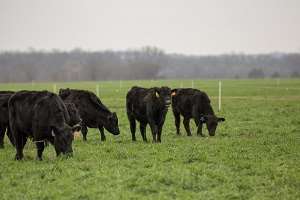By Dr. Derrell Peel,
Oklahoma State University Extension Livestock Marketing Specialist
Dr. Derrell Peel, Oklahoma State University Extension Livestock Marketing Specialist, offers his economic analysis of the beef cattle industry. This analysis is a part of the weekly series known as the "Cow Calf Corner" published electronically by Dr. Peel and Dr. Glenn Selk. Today, Dr. analyzes the dynamics of the beef markets that will come into play over the new year, accounting for growth in consumption and projected production forecasts.

"Retail beef prices will continue adjusting down in 2017 due to retail market dynamics and continued growth in domestic beef consumption this year. The most recent All Fresh retail beef prices in November were $554.20/cwt., down 7.5 percent from one year earlier. All Fresh retail beef prices peaked in July, 2015 and have decreased 9.8 percent from the peak through November, 2016.
"The average monthly price decrease since the peak has been 0.6 percent per month but the rate of decrease accelerated in the fourth quarter (Q4) of 2016. November All Fresh beef prices were down 1.7 percent from October following a 1.9 percent monthly decrease in October from September. A faster decrease is not surprising given the jump in beef consumption in Q4 of 2016. Fourth quarter beef production was up a projected 8.3 percent year over year and, when adjusted for fewer beef imports and increased beef exports, resulted in a projected 6.5 percent increase in per capita retail beef consumption compared to Q4 of the previous year. Sharply higher Q4 beef production in 2016 contributed to a projected annual increase in per capita beef consumption of 3.1 percent for the year.
"Beef production is forecast to increase year over year by 3.5-4.0 percent in 2017 leading to an expected increase in consumption of 1.3 percent year over year. The consumption increase on a quarter by quarter basis will be relatively modest compared to the sharp jump in domestic consumption in late 2016. The current projection for 2017 domestic beef consumption hinges on the projection for total beef production as well as continued improvements in the net beef trade balance. Increased beef consumption may be interpreted by some as better beef demand while lower retail prices might suggest lower beef demand. In reality, it is the magnitude of retail price adjustments relative to increased consumption that defines the level of beef demand. In general, lower retail prices in the face of increased beef supplies are the expected response for a given level of demand. However, other factors such as pork and poultry prices and macroeconomic conditions may shift beef demand.